Opening the Prosecution Case

The bend in Castle Lane - approximately the position of the attack on F. W. Budd - seen in May 2009
On 10th May 1863 Bedford solicitor William Frederick Budd was attacked in Castle Lane and later died of his injuries. The alleged attackers were brought to trial at the Assizes on 21st July that year. The Bedfordshire Times have a blow by blow account of the trial to its readers.
![bert Jordan in the Bedford Gaol Register [QGV10/4]](/CommunityHistories/Bedford/BedfordImages/Robert Jordan QGV10-4-62.jpg)
Robert Jordan in the Bedford Gaol Register [QGV10/4]
“The indictment charged Robert Jordan (21), a smith, and William Craddock (33), a carpenter, with the wilful murder of Frederick William Budd, a solicitor, in the parish of Saint Paul, Bedford, on the 10th of May”.
![William Craddock in thre Bedford Gaol Register [QGV10/4]](/CommunityHistories/Bedford/BedfordImages/William Craddock QGV10-4-61.jpg)
William Craddock in thre Bedford Gaol Register [QGV10/4]
“Both prisoners pleaded Not Guilty”.
“The prisoners were also charged under the Coroner’s warrant with the same offence, to which they also pleaded Not Guilty”.
“Mr. Mills, Q. C., and Mr. Stephenson, the Recorder of Bedford, instructed by Mr. James Pearse, conducted the prosecution; Mr. Metcalfe, instructed by Messrs. Conquest and Stimson, appeared for Jordan; and Mr. Serjeant Tozer, instructed by Mr. Jessopp, defended Craddock”.
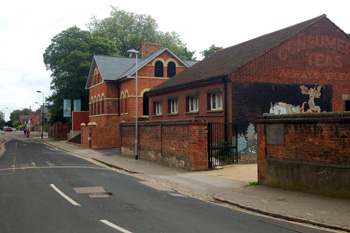
Castle Lane looking towards the Castle Rooms
“Mr. Mills Q. C., stated the case for the prosecution. He said he appeared in this case with his learned friend Mr. Stephenson, to lay before them the facts connected with the death of Mr. Frederick William Budd. Mr. Budd was a member of the profession of the law, a native of this town, and at the time of his death residing in it, but previously practising at Buckingham. He came by his death on the night of the 10th of May, when he was walking peaceably along the public street by the side of his wife, on the way to his own house. He was there felled to the ground, beaten most cruelly, and died in a few hours afterwards from the injuries inflicted. The jury had on this occasion to try the two men charged with causing his death, and to ascertain from the circumstances which would be laid before them whether the prisoners at the bar were guilty of murder or manslaughter. In order to constitute murder it was not necessary to show that the men intended to kill when they inflicted the blows, which caused death; it sufficed that if the conduct of the men indicated such a violence of temper and the attack being of such a formidable description as to cause the death of the party, this sufficed to constitute, in the language of the law, a case of murder. It was not necessary to show that the men premeditated death, if the circumstances were such as to indicate a wickedness of heart and a total disregard of the consequences. Subject to the direction of his Lordship, this is the question they had to try; and he would proceed to detail the facts of the case. On the 10th of May Mr. Budd, in company with Mr. Pulley, passed the evening at Mr. Trapp’s friend [Thomas Simmons Trapp, Justice of the Peace], of the High-street in this town – the house of a mutual friend; Mrs. Budd spending the evening with the Misses Pulley. Between ten and eleven Mr. Budd accompanied Mr. Pulley to the house of the latter in St. Paul’s-square, and then proceeded with his wife on their way home, in the Kimbolton-road. In order to get from the square to the Kimbolton-road the best and shortest way would be to turn down Castle-lane, which the jury would perceive from the plans, after some distance is traversed, bends to the left, and then shortly after to the right. Just at the bend to the right the Rose-yard and the Ram-yard, narrow thoroughfares, are situated to the left. Proceeding to the right, the parties would pass the Castle Rooms, and then turning to the left would go by St. Cuthbert’s church, which is on the right as you pass on to St. Cuthbert’s-street, on the left hand side of which Lurke-lane appears, as marked on the map, and by this road the deceased in time would reach his own house in Kimbolton-road. On the night of the 10th of May he should show that the deceased, with his wife upon his arm was proceeding along Castle-lane. After they had passed Mr. Higgins’s brewery, Mr. Budd noticed there were five men in the road, standing as it appeared across the road. These five men consisted of the two prisoners, a black man named Jenkins, his companion, named Keeler, a diver, and a person named Hatton. When they had passed the last three men something occurred which he would explain presently. One of the two men in front, Craddock, turned round, and whether intentionally or unintentionally he could not say, he brushed against Mr. Budd, who was walking with his wife upon his arm, said to the man, “What do you want by that, give me your name”. Craddock immediately struck him a violent blow upon the head, saying, “That is my name”. The other prisoner Jordan then came forward and assaulted the unfortunate man. Utterly unable to defend himself against their violent attack, he was beaten about the head and face, stunned by the heavy blows, and fell to the ground. Mrs. Budd assisted her husband up; but what is hardly credible. The two ruffians again assaulted the unhappy man, knocked him down, and beat him when he was helpless on the ground, leaving him in a state of unconsciousness. His wife remains by his side, and immediately afterwards two men came up, named Warner and Berridge, and assist the unfortunate man on his legs. After going with him a few paces they walked forward and three soldiers, on their way to their billets, overtake him. He informs them he has been grossly assaulted, and the three soldiers accompany him along St. Cuthbert’s-street as far as Lurke-lane. He then thanks the three soldiers for their kindness and walks on very slowly with his wife towards Kimbolton-road. The unfortunate man had sense enough, however incoherent his statements, to inform the police. That he received his death blow from the two prisoners there can be no doubt, although Mr. Budd’s account of the transaction appeared rather confused – arising from the effects of injuries he had received. He was attended by a medical man that night, but he died from extravasation of blood upon the brain, produced by external violence. Thus this unhappy man was killed upon this night, under circumstances of the most outrageous description. He was assaulted in the public streets, knocked down by two men, and received such injury as caused his death a few hours afterwards. It was hardly possible to conceive anything more distressing on the one side and malicious and brutal on the other. Not the slightest provocation had been given. Mr. Budd, when rudely pushed against, said to the man, “What do you mean by that?” or words to that effect, when they set upon him and beat him over and over again, fractured his skull, which eventually caused his death. To bring the offence home to the prisoners he should like to call those men who were with them on the night in question drinking together at several public-houses. Two of the men were total strangers and accidentally met with the prisoners for the first time in the course of that night. The five men were at the Rifle, a public house in the High-street, from which place they proceeded down the Ram-yard towards the Castle-rooms, near which the transaction took place. It was true Mrs. Budd could not identify the prisoners, but the three men were close to the spot and saw the whole transaction; and after hearing their testimony the jury would be enabled to determine whether their evidence could be relied on. They would swear that the two men inflicted the injuries. If a man be attacked in the public street without having given the slightest provocation, and such injuries were inflicted upon him as to occasion his death – injuries inflicted not by mere accident, but from repeated attacks – it appeared to him that death produced in such a manner must be regarded as a case of murder, and not manslaughter. If a man be unlawfully and cruelly beaten to death – if he be violently assaulted without having given the slightest provocation, and the violence repeated in such a manner as to cause his death – until he had been told by an undoubted authority to the contrary, he could not believe that an offence committed under such circumstances was less than murder. After some further observations the learned counsel called the following evidence in support of the charge: -“
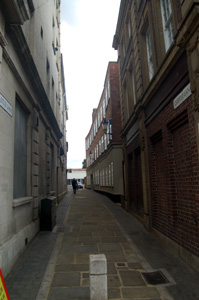
High Street entrance to Castle Lane May 2009
“James Horsford sworn: I am a surveyor, and made a plan of the locality, of which the tracings produced are copies. The plan shows the road taken by the deceased Mr. Budd and his wife, from Mr. Pulley’s St.-Paul’s-square, along Castle-lane, St-Cuthbert’s-street, to his residence on the Kimbolton-road”.
“Cross-examined by Mr. Metcalfe: The length of the Rose-yard is about 100 yards; from the end of the Rose-yard to the corner turning towards St. Cuthbert’s is about 100 yards; from the end of the Rose-yard to the turning opposite the gates of Mr. Higgins’s brewery, and leading to the High-street, the space is about 70 yards. I believe there is a lamp nearly opposite Mr. Higgins’s brewery gates, and also one near the Rose-yard”.
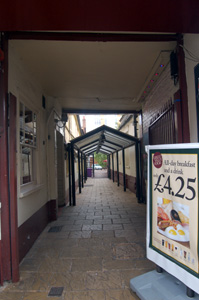
High Street Entrance to Rose Yard May 2009
“Re-examined: There is a lamp opposite Mr. Higgins’s house-gates near St. Cuthbert’s end of Castle-lane, and it can be seen from the end of the Rose-yard”.
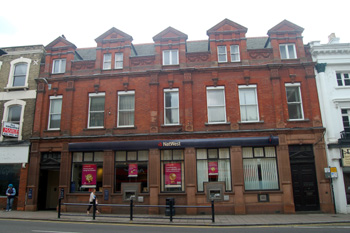
National Westminster Bank 81-83 High Street May 2009 - Trapp's house would have been on the left side of the bank
“Henry Pulley: I reside in St. Paul’s-square. I knew the deceased intimately. He and Mrs. Budd came to my house on Sunday morning, the 10th of May, and I accompanied them to the morning service at St. Paul’s Church. The deceased and his wife came in the afternoon. I took supper with him at Mr. Trapp’s, in the High-street, and Mrs. Budd spent the evening with my sisters in St. Paul’s-square. I returned with the deceased from Mr. Trapp’s to my house about 11 o’clock, and he left with his wife to return home. He was perfectly sober”.
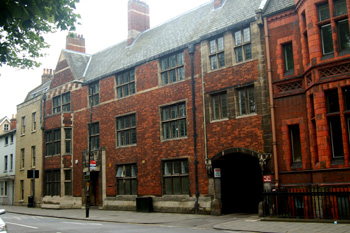 The site of 5 Saint Paul's Square seen in may 2009 - this part of Shire Hall was built in 1910
The site of 5 Saint Paul's Square seen in may 2009 - this part of Shire Hall was built in 1910